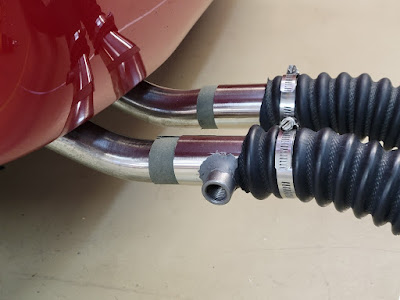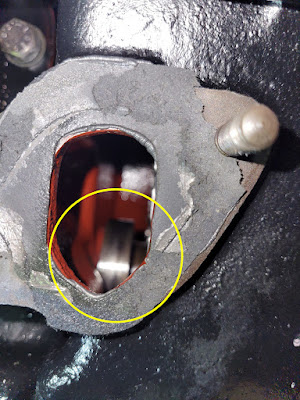 |
| The Alfatross' pair of Solex 40 P II carburetors. |
 |
| A Solex 40 P II carb on a Porsche 550 Spyder. |
 |
| An original VéloSoleX. |
 |
| It helps to have PhDs in fluid dynamics, materials, and engineering! |
Solex has a long and distinguished history. Co-founders Maurice Goudard and Marcel Mennesson, both of whom are unknown to Wikipedia, created the company in 1905. The company’s first product was a primitive (by modern standards) motorized bicycle they called VéloSoleX. Making carburetors later became their specialty. In any case, The Alfatross’ Solexes were the product of half a century of mechanical and fluid dynamics evolution and refinement. The good news is that Solex carbs and parts are or were manufactured under license over the decades by many companies in many countries. The bad news is that they seem to have been in a constant state of evolution so there are many subtle variations of the same model.
That leaves The Alfatross and me to work things out together. I noticed that a number of The Alfatross’ siblings have been treated to more modern carburetor “upgrades” such as downdraft and sidedraft Webers, and after dealing with The Alfatross’ pair, I can understand why.
Each carb has about 125 parts, all of which are necessary for it to mix air and fuel under a variety of different ambient and operating conditions. It is no small accomplishment to get all the adjustments on both carburetors set properly so that they work together. But when the environment changes drastically, so do the settings.
The carbs were initially adjusted to run well in Scottsdale, AZ at an altitude of about 350 meters (1,200 ft). Here in Santa Fe, the highest capitol city in the US, the elevation is 2,200 meters (7,200 ft), so readjustment, including changing idle and main jets, is necessary.
 |
| Original injectors exposed. |
After determining that the fuel pumps were providing about 3 psi of pressure and the fuel lines and filters were clear, I started looking at the carburetors themselves. One problem was immediately obvious: while the accelerator pump's injectors on the rear carb were working well, the injector streams on the front carb were weak. Adjusting the linkage on the front pump had no visible effect.
 |
| Original injector and ball valve. |
While disassembling both pumps, cleaning them, and replacing the gaskets, I tackled the injectors and immediately hit a snag. During the disassembly process the ball that serves as a check valve to prevent the gas already in the injector from draining back into the bowl popped out onto the floor and vanished as if teleported to a parallel universe. If this sounds like an excuse for not conducting a thorough search, try looking for a 3mm clear plastic, extremely bouncy, ball on the floor of a typical garage floor strewn with dust bunnies and other tiny debris. When you lose something on the floor that can't be seen or felt or picked up with a magnet, your last resort is to look for another one on the internet.
 |
| Original injector (left) with new version. |
 |
| Some material filing necessary! |
Much to my surprise I found a site on eBay offering replacement injectors in a set of 4! When the jets arrived and I compared them with the originals, I discovered a number of minor differences: The blocks holding the injectors to the carb bodies were slightly longer than the originals but would fit after filing some material off the block. No big deal. The balls inside the lower part of the original injectors were removable, probably so the tubes could be cleaned, but the sealed one-way valves in the new design seem to be an improvement--at least it lessens the probability of losing the ball! Another difference is that the original injector orifices were 0.35mm, but the new ones are 0.40mm. Will that make a difference? I hope not, but we will soon see!
The Solex Saga continues . . . .















